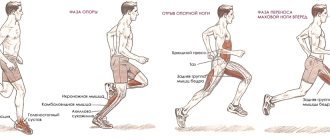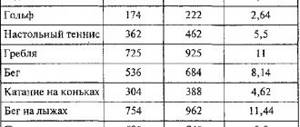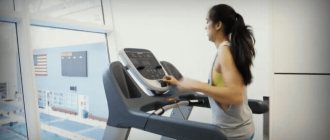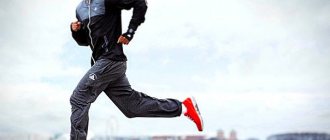Start slow.
Do not rush. You won't have time to qualify for the London Olympics. I understand that in the spring it is very difficult to curb enthusiasm. Trust me, it's better to start slow. Moreover, even if you are a former athlete and think that your fitness level is very high, be conservative. Last fall, my neighbor, a former champion of Moscow in hurdles (this was in his distant youth), decided, looking at me, to prepare for a marathon. Came out for my first run. I spent a long time proving to him that there is no need to run more than 4 km. But he resisted. Ran ten with me. The next day and throughout the next week, I had difficulty walking, couldn’t climb stairs, gave up running, and forgot about the marathon. This is a bad example for a beginner. Set yourself the most conservative goals for the first week. Don't think that someone will laugh at you. This someone is not interesting to you. Only YOU are interesting! Nobody else. You must succeed: become a fast, strong, slim and confident person. So give yourself time and everything will work out.
Load and rest
- Rest is no less important part of the training process than exercise.
- A reasonable balance of relaxation and stress is a good basis for progress or maintaining good physical shape without injury.
- The program of courses and recreation is a purely individual thing and, in fact, completely depends on the level of training of the athletes. For a professional runner, a typical program is "2 workouts per day", with a daily "fast" run. For a beginner who is accustomed only to running loads, exercise 3-4 times a week is enough.
Time, not kilometers.
This is important for beginners. If you decide to start running, run for 10 minutes the first time. Then increase the time gradually until you reach forty minutes of running. If you calmly run for forty minutes without stopping, then that’s it, you can move on to taking into account kilometers, distances, speed, pace, and so on. If you immediately start thinking in terms of kilometers and, God forbid, comparing your first race with a marathon, it may seem to you that all this is a waste of time, that it is impossible. It's demotivating. But if, starting small, feeling the ease of running and the pleasure of training, you slowly move forward, then you will definitely reach your goal. That's for sure. My first workout was on the treadmill and lasted exactly seven minutes. Having run 5 marathons, although not very fast, I can definitely tell you that seven minutes is also the beginning of a long and interesting journey.
Training clothes and shoes
Before you start running, you need to decide what to wear for your running training. It's time to buy sports equipment.
Shoes
For the warm season, you will need sneakers with medium-hard soles. Such a sole is needed so that you can run both on asphalt and along forest paths.
It is known that a hard surface and lack of shock absorption have a bad effect on the knee joints and ankles. Therefore, you need to solve this problem with the help of a sole. Too soft springy soles are not suitable in our case, as they will quickly wear out when running on the street. Sneakers should not be slippery. The main tasks of shoes are: shock absorption of the feet on the road and good grip.
Sneakers are definitely not suitable for running, as their soles are too thin. You can hit your feet on the asphalt.
If your shoes have laces, pay attention to what kind they are. We will only be interested in flat laces. In no case are they round - they come undone quickly, and every 500 meters you will have to stop to lace them up.
In winter, sneakers should be insulated. Many sports brands have such models in their assortment. You should pay attention to the comfort of your shoes so that nothing rubs you anywhere.
Starting running without the right shoes, wearing “what you have” is an illiterate approach that will quickly discourage you from training.
Tracksuit and jacket
When you run, no matter what your goal is, you will sweat. Accordingly, you need clothing that can wick moisture away from the body well. The greenhouse effect created in low-quality suits is undesirable, since the body will overheat, and you will have to forget about comfort.
You can take sweatpants and a sweater separately, and a jacket if necessary. You should wear a comfortable T-shirt underneath. Clothing should not restrict movement.
The jacket should be light so that you don't get too hot. It is advisable that the collar covers the throat. At low temperatures outside, this will save you from sore throats and colds.
In hot weather, you can wear shorts and a T-shirt while jogging. Today, sports stores are full of clothes for active pastime, so buying clothes for running is not a problem at all.
Hats
In winter and in the cold off-season, you should have a hat on your head. The fabric of the hat needs to be light and moisture wicking. Running in winter without a hat is a thankless task, as you can easily catch a cold and get more harm from training than good.
Special caps for skiing and running can be found in sports stores.
In winter, you will also need gloves; they must meet the same criteria as a hat.
There is a lot that can be said about running for beginners. Now we will give some tips on where to run, when, how to breathe while running and how, in general, to run in different situations.
You must have a plan.
It's not even about training. You can download the basic plan on the Internet, or you can view it on our website. But that's not the point. The point is in general terms for the week. You need to fit running into your regular lifestyle, so you must start clearly planning your entire schedule and include running in it. Analyze your week and see where you spend your time. I assure you that if you take the trouble to write down in a notebook exactly by the hour what you did for at least two or three days, you will definitely find time to run. Very often we do not notice how we are wasting our time. We watch TV, go to a cafe or just surf the Internet. By writing everything down, you will definitely find a way to optimize your day. You must (must) explain to your friends and family that running is very important to you.
The right equipment
A runner's outfit includes different sets of clothing depending on the time of year and the outside temperature. The shoe that remains unchanged is sneakers.
What should sneakers be like?
Lightweight ~400 grams, toe box easy to bend, springy heel.
Why sneakers?
A distinctive feature of sneakers from sneakers is their preparedness for the type of load. If such points as lightness and a soft toe can have both options, then the heel of a sneaker does not have a springy effect. A small detail, but it plays an important role, because... When constantly using sneakers as running shoes, the athlete’s heel gets knocked out, which subsequently leads to knee pain. In addition, running in sneakers will be easier, because... a higher heel promotes forward movement.
Summer equipment
As a rule, a runner's outfit in summer is short: T-shirt, shorts.
Sneakers. Lightweight, soft toe, springy heel.
Socks. There is a lot of debate about the length of socks. We are of the opinion that they should be short. And of course, allow the skin to breathe as much as possible.
Shorts. Should be above the knee so as not to restrict forward movement. Well secured, for example with a lace or a tight elastic band.
T-shirt. Should allow the skin to breathe. It should not restrict the movement of the arms, preferably fitted, with short sleeves or without it at all (T-shirt).
Winter equipment
Winter equipment should not allow air to directly penetrate the body. Standard set of equipment: socks, sneakers, sweatpants, sweatshirt (tank top), gloves, hat.
Socks. Now there is no need to talk about length. It is important that the socks are comfortable and do not crowd the foot in the sneakers.
Sneakers. All the same light and comfortable. Some runners specifically purchase shoes with studded soles for better traction on slippery surfaces.
Sports trousers. There are no special criteria. The only desirable thing is the warm interior. Knitted pants work well for this purpose.
Olympic. The collar should cover the throat as much as possible from oncoming cold air. The sleeve may have an elastic band. The bike will be warmer. It is worth noting here that the choice is about comfort for everyone.
Gloves. A mandatory attribute that many beginners neglect to run. During running, the hands are the least active, especially the outer side of the hand freezes. A lot of heat comes out through your hands.
A cap. The leader in retaining heat is a hat. More heat comes out through the head than through the hands. An alternative would be a headband or a bike hood - better than nothing.
In case spring turns out to be cold and late autumn is warm, remember a simple rule: +15 and above – short clothing, +14 and below – long clothing.
Be creative when finding time to run.
If, based on point 4, you have absolutely no option to carve out an extra hour a day, look at things from a different angle. Maybe you can run home from work, putting your work clothes in your backpack? If you take your child to clubs, you can not just stupidly wait for him in the hall, but run around somewhere nearby at this time. You can finally get up an hour earlier. What to do? Beauty requires sacrifice. Trust me, your sacrifices will pay off. Once at Sheremetyevo Airport, we saw an airport employee, in his work clothes, change into his sneakers and go for a run (apparently during his lunch break). Like this. And according to surveys in the UK, 2 million people on average spend their lunch break running. Do you think that after running you can’t do without a shower? But UK office clerks don’t think so; they wash in the sinks of their offices, use wet wipes, and experience all these inconveniences for the sake of one thing – their health. Anything is possible, you just have to want it.
Place for jogging
It is better to start learning to run at a sports stadium, where special circular paths are allocated for this.
It is very convenient to run there, counting the laps you complete. At first, you can not focus on time, but simply analyze your results based on the number of laps completed. If you want to vary the distances, keep in mind that the inner circle is smaller than the outer one. If the stadium is not enough for you, run around the outer circle.
You can set yourself a goal, for example, to run 10 laps during a workout. And you can start with 1-2 laps at an average pace.
A running program for beginners at a stadium should take into account the time of year, the characteristics of the body and the climatic conditions of the region.
Jogging can be practiced in forests, park areas, quiet and peaceful places. If you are going to run around your area, this is acceptable, as long as there are not many cars on the roads in the morning. The air in the morning is not as dirty as in the afternoon or evening.
Some countries have special places for runners. Comfortable non-slip paths lead through green forests. There is fresh air and the sound of birds. This is all very impressive.
Set a goal.
It motivates. You don’t have to tell anyone about your goal, in case it seems crazy to others. Who cares what others think? The main thing is that this goal motivates you personally. If today you weigh 150 kg, and your goal is to become like Brad Pitt, great. Believe me, it's possible. Not tomorrow or even the day after tomorrow, but perhaps. When you lose weight to 80 kg, perhaps you will change the goal and say to yourself: “What do I need Brad Pitt? Who is he anyway? I want to be like Lance Armstrong and overcome Ironman!” Go for it! The main thing is, don’t get caught up in the little things, don’t set boundaries for yourself. BUT! It is very important to correctly break down this goal into tasks. Let's take our example with 150 kg. You tell yourself, “OK. I will eat only the right food for a week and walk every day, at a brisk pace, first for 20 minutes, and then for an hour.” And you stick to this little program for a week. Next, you look at how your body and well-being have changed during the first week, adjust the plan, and create a task for the next week. And so on. This principle works for any purpose. Whether it's just losing weight or wanting to finish a marathon. Motivation requires a goal.
Running for beginners
The multimillion-strong, ever-growing army of followers of running training confirms the fact proven by scientific research and tested in practice - running is a high-quality and affordable tool for improving health.
Positive changes that occur in the functional state of the body during recreational jogging:
Work of the heart
By increasing the volume of the heart chambers, the volume of pumped blood increases. The frequency (heart rate) and strength of heart contractions during exercise increases, and in a calm state, a trained heart works economically, with a heart rate of up to 60 beats per minute, which increases its resource.
Vessels
Under the influence of regular stress, blood vessels stretch, become elastic, and increase their lumen. As a result, blood pressure stabilizes and blood circulation improves.
Musculature
Active work of the muscles of the lower extremities, buttocks, and abdominal muscles has a beneficial effect on their harmonious development and strengthens the respiratory muscles. The vital capacity of the lungs increases significantly.
Weight
Aerobic exercise, which includes running, speeds up metabolic processes, helping to burn excess calories faster and normalize weight.
Immunity
Immunoglobulins are formed in the blood, increasing the body's resistance to diseases.
Emotional condition
Stress and overexertion are relieved by the production of the hormone endorphin, which causes feelings of joy and helps to more easily overcome life's troubles.
Where to start running
A beginner should start running training by visiting a doctor (LINK: The benefits and harms of running. Top 10 arguments). If you have a history of diseases with contraindications to this type of physical activity, then you should not try to aggravate the problems.
What diagnoses are taboo:
- congenital heart defects;
- heart rhythm disturbances;
- circulatory disorders;
- thrombophlebitis of the lower extremities.
When to temporarily delay starting a run:
- for chronic diseases;
— after illness, until complete rehabilitation;
- when you feel unwell.
The apparent simplicity of running is fraught with danger for beginners. Unsystematic training will not give the desired result and can “discourage” the desire to run for a long time. Drawing up a training plan will be the key to their effectiveness and will allow you to gradually prepare the body to achieve new goals.
How to “build” a running workout for beginners
Form
Comfortable and practical clothes will help you feel confident and comfortable at a distance. Preference in equipment should be given to loose-fitting clothing made from natural fabrics (up to 80% of the composition), which will ensure sufficient heat exchange. Shoes are selected depending on the covering. If you plan to run on soft ground (stadium, park or forest paths), sneakers are suitable. For beginners, when running on asphalt, it is better to wear sneakers (the thin sole of the sneaker will transfer additional load to your feet).
Warm-up
Preparing your muscles, joints and ligaments will reduce the risk of injury during the race. Typically, various running tasks are included in the warm-up before the main training program. In the case when running itself will be the basis of the training, the warm-up should be carried out with the simplest preparatory exercises: bending the torso, rotations in the cervical and lumbar spine, squats, lunges, jumping in place, rotations in the ankle joint.
Running program for beginners
The running program for beginners includes short runs alternating with walking (alternating method) in order to adapt the muscles and prepare the functional state of the body for a new type of load. The optimal initial frequency and duration of training is three times a week for 30-40 minutes. After 3 months of regular training, the physiological mechanism will “launch” at full capacity the work of all systems, providing the opportunity to further increase the intensity of training.
Experts have developed many different running schedules for beginners, which allows you to choose an acceptable option for people of different age categories, starting physical conditions and employment.
Table 1. Example of an entry-level program
| A week | Number of workouts | Content |
| 1 | 1, 2, 3 | Walk for 5 minutes at a fast pace. Alternating walking and running 20 minutes – 1 minute jogging + 1.5 minutes walking |
| 2 | 1, 2, 3 | Walk for 5 minutes at a fast pace. Alternating walking and running 20 minutes – 1.5 minutes jogging + 2 minutes walking |
| 3 | 1, 2, 3 | Walk 5 minutes. Jog 1.5 minutes, walk 1.5 minutes, jog 3 minutes, walk 3 minutes, jog 1.5 minutes, walk 1.5 minutes, run 3 minutes, walk 3 minutes |
| 4 | 1, 2, 3 | Walk at a fast pace - 5 minutes, jog 3 minutes, walk 1.5 minutes, jog 5 minutes, walk 2.5 minutes, run 3 minutes, walk 1.5 minutes, run 5 minutes |
| 5 | 1 | 5 minutes brisk walking, 5 minutes jogging, 3 minutes walking, 5 minutes jogging, 3 minutes walking, 5 minutes jogging |
| 2 | 5 minutes walking, 8 minutes jogging, 5 minutes walking, 8 minutes jogging | |
| 3 | 5 minutes walking and 20 minutes jogging | |
| 6 | 1 | 5 minutes brisk walking, then jogging 5 minutes, walking 3 minutes, running 8 minutes, walking 3 minutes, running 5 minutes |
| 2 | 5 minutes walk, 10 minutes jogging, 3 minutes walking, 10 minutes jogging | |
| 3 | 5 minutes walking and 25 minutes jogging | |
| 7 | 1, 2, 3 | Walking fast - 5 minutes and jogging for 25 minutes |
| 8 | 1, 2, 3 | Walking at a fast pace - 5 minutes, jogging 28 minutes |
| 9 | 1, 2, 3 | Walking at a fast pace - 5 minutes and 30 minutes jogging |
Running schedule according to the method of American trainer G. Bakoulis
10-week cycle with 3 training sessions per day using the alternating method
Table 2. Running schedule according to the Bakoulis method
| A week | Contents of the training |
| 1 | Alternation: 2 minutes running and 4 minutes walking |
| 2 | 3 minutes run, 3 minutes walk |
| 3 | 4 minutes run, 2 minutes walk |
| 4 | 5 minutes run, 3 minutes walk |
| 5 | 7 minutes run, 3 minutes walk |
| 6 | 8 minutes run, 2 minutes walk |
| 7 | 9 minutes run, 1 minute walk |
| 8 | 13 minutes run, 2 minutes walk |
| 9 | 14 minutes run, 1 minute walk |
| 10 | Running only for 20-30 minutes |
Example of a three-week training program
Table 3. Running program - three workouts a day
| A week | Monday | Wednesday | Friday |
| 1 | 5 minutes of running | 10 minutes of running | 20 minutes of running |
| 2 | 30 minutes of running | 40 minutes of running | 50 minutes of running |
| 3 | 60 minutes of running | 70 minutes of running | 80 minutes of running |
Further training follows the same schedule, lasting no more than 80 minutes, gradually increasing the pace in the races.
Advice from seasoned runners
Classic mistake
Beginners tend to increase their pace and distance faster. If you are preparing for serious long-term work, then you must adhere to the rule “hurry up, take your time.” Every week you need to add 10% intensity or distance. If in the first week the training time was 120 minutes, then the next week you should train for 132 minutes - no more and no less. The same principle applies to increasing mileage.
Each workout begins and ends with a 5-minute stroll. A sudden stop after exercise harms the cardiovascular system.
Variety of the training process. It is useful to change routes and types of surfaces. A good motivation not to miss training will be training in a group of like-minded people. Keeping a training diary is a good idea - adjusting loads will help you make progress and stimulate further improvement.
Optimal load
For beginners, running three times a week has a physiological basis. The recovery period for the body after physical activity is 48 hours, so without proper rest it is impossible to achieve a healing effect.
Do not start training earlier than 1.5 - 2 hours after eating. Incompletely digested food can cause cramps and even vomiting during the race. After a run, you can immediately quench your thirst (not with cold or carbonated water).
Age is not a barrier. You can start running at any age, unless there are medical contraindications. Health running does not pursue the goals of sports training aimed at setting records and involving excessive effort. There are special running programs for beginners and older amateurs, taking into account physical fitness and health status. The use of “gentle” techniques will not harm the body of veterans and will protect them from injury.
Basics of healthy running technique for beginners
Walking and running skills are inherent from birth, which greatly facilitates the process of improving technique. What you should pay attention to so that running is natural and free:
— The position of the body - a straight back and straightened, slightly lowered shoulders, give the correct position to the spine and help maintain rhythmic deep breathing;
— Arms are bent at the elbows, actively moving along the body;
- Keep your head straight, gaze directed forward;
— Foot placement is one of the most important elements of technique. The foot should be placed on the toe, with a roll over the entire plantar part. Standing on your heel overloads your joints.
Step length determines your running pace. The step should not force you to “partially” or “float”. If your breathing begins to become uneven or shortness of breath occurs when running, this is a signal to slow down or start walking. There is a good test to determine the acceptable intensity of running: speak a couple of sentences fluently and coherently during the race. If it doesn’t work, then the pace has been set too high.
Breath
It is correct to take a long breath through your nose and exhale briefly through your mouth. If a runner begins to gasp for air, this is a signal of overexertion.
Methods for assessing running performance
An accessible and objective criterion showing the body’s “attitude” to the proposed physical activity is the dynamics of pulse changes. Sports physiology suggests focusing on the following indicators:
Heart rate recovery: 10 minutes after training, the pulse should not exceed 100 beats per minute. After an hour - no more than 10 beats per minute above normal.
If morning heart rate measurements (immediately after waking up) show a persistent downward trend, then the running program is adequate and positive changes occur in the functional state of the body.
Maximum permissible heart rate values when running for beginners
Table 4. Heart rate when running for beginners
| Age/years | Heart rate (HR)/minute |
| 20 — 25 | Up to 150 hits |
| 25 — 30 | Up to 140 hits |
| 40 | Up to 135 hits |
| 50 | Up to 125 hits |
| 60 | Up to 120 hits |
| 70 | Up to 110 hits |
For women, the figures are 5 beats per minute more
Types of running loads
Jogging
Characterized by calm, measured movements. Can be used as a permanent type of running training (suitable for older amateurs), and as an element of the warm-up and final stages of the lesson.
Shuttle run
Short runs (15-30 m) with a 180 degree turn.
Smooth running
The main type of training process for a beginning runner. The speed, distance, type of coverage, and terrain conditions vary.
Sprint and marathon are sports disciplines that require long-term preparatory work from the amateur.
Any physical activity will benefit the body. Running attracts with its accessibility and high efficiency, improving the quality of life and delaying the aging process.
https://www.youtube.com/watch?v=-SfCfWS2apA
About shoes and more.
A beginner runner needs almost nothing. You can use old sweatpants and a T-shirt. BUT! You need to think hard about your shoes. You need to study the information on the websites of major shoe manufacturers. Understand what type of sneakers is right for you based on your budget. When ordering shoes abroad, it often happens that the price is cheaper than here in Russia. This option is not for beginners. You need to come to the store, try it out, run, jump in new sneakers. Pick up "live". Then, when you become an experienced runner and acquire running technique, it will become clear to you what is suitable and what is not. And then you will be able to use discounts, online stores, and so on. In the meantime, run to a good store where large, reputable manufacturers are represented and guarantee quality.
For women.
Girls, in addition to sneakers, definitely need good breast support. Stores sell special underwear for running. A bra with good support will cost from 700 to 3000 rubles. There are also special running jerseys with built-in chest support. Make sure you're wearing the right underwear with enough support, otherwise your workout will be hell.
Running technique should depend on the type of running
Different types of running require different foot positions. For example, when jogging, the foot is placed from heel to toe or immediately to the entire surface. It turns out to be a “shuffling” run, slightly faster than walking.
During normal running, landing on your heel injures your spine. If your back hurts after a run, reconsider your running technique.
It is safe to place your foot on your toes (rest on your big toe) and gently lower it onto your heel. As soon as the heel touches the ground, the next step is taken. The hips are kept straight, without tilting inward or to the sides. Leg movements are parallel. The feet also point straight. Landing on the outside of the sole can cause injury.
Rest.
You have started a new life. You watched the movie “Rambo” again and how Sylvester Stallone’s hero is ready to tramp through the city streets day and night, not knowing fatigue. Wait... This is a movie. In life, to achieve success in sports, oddly enough, you need to rest. The most important part of training is recovery. Kenyan marathon great Marie Keitany sleeps 16 hours a day. Why? She considers sleep an important part of the recovery process. Don't run every day, give your body and muscles rest. Even elite runners give themselves one day a week of complete rest. If you don't rest, you will either overtrain, get sick due to a weakened immune system, or get injured. This will not lead you to the goal that you set for yourself based on point 6. First, run every other day, then 5 days a week. 5 days a week, in principle, is enough to build a training schedule for a half-marathon or marathon. Most schedules give 6 days of training, of which 2-3 days are easy, recovery runs. Do not neglect this rule - be sure to rest.
How to choose running clothes?
Equipment is selected according to the season. For a summer run, shorts and a T-shirt are suitable. If it's cool outside, a light windbreaker will come in handy. To keep your leg muscles from getting too cold, wear leg warmers or sweatpants. In winter, it is better to wear a tracksuit that suits the season and a light hat.
You should not wear special insulation, as it will get hot during a run. At +10 degrees, it is recommended to dress as if it were +20 outside. Clothes should not restrict movement, fall off, or interfere. Choose shoes with flat soles.
Bad habits.
I insist that you have to quit smoking completely. There is no compromise here. Either cigarettes or running. Aerobic exercise is incompatible with tars and other decay products that enter the lungs along with cigarette smoke. Choose either a body like Brad Pitt (Angelina Jolie) or cigarettes. It's not easy with alcohol either. Strong alcohol is not compatible with regular training. Light alcohol in the form of beer and wine is possible, but it all depends on the quantity. If you are not able to stop at one or two glasses and are accustomed, according to the Russian tradition, to drinking until you drop, then training is unlikely to be regular. Therefore, if moderation is not your strong point, you will have to quit completely. If you can maintain moderate consumption of weak alcohol, then remember that alcohol dehydrates. This means that when taking it, you need to increase the amount of water you drink.
Where should a newbie start? Brief instructions
Shoes bought, watch on hand. It's time to run! A standard workout for amateurs looks like this:
- warm-up (exercise) for 5-10 minutes to stretch and warm up the muscles;
- easy running without acceleration for 20 minutes at a pace at which it is easy to talk without shortness of breath;
- short-term acceleration;
- Stretching – exercises for the muscles of the legs and back.
The acceleration lasts as long as the runner maintains the pace. If your legs get tired or shortness of breath appears, slow down and maintain the pace until your breathing returns. The run ends gradually; you cannot stop abruptly and stand in one place, restoring your breathing. It is better to slow down and start walking until your breathing returns to normal.
To make running enjoyable, run with pleasure, without forcing or overloading yourself. The result will be noticeable within a month. Running will become easy, shortness of breath will disappear, breathing will quickly return to normal, and the leg muscles will strengthen and become toned.
HOW TO START RUNNING? EVERYTHING YOU NEED TO KNOW!
Water.
If you start running regularly, develop the habit of drinking water regularly as well. Your body must be hydrated. This will help a lot in training. You need to drink throughout the day. Simply drinking half a liter of water before a run in the hope that it will make up for everything you didn't drink beforehand won't help. In this case, you will simply need to go to the toilet very quickly, and the training will be disrupted. So, you need to drink plain water constantly, throughout the day. While you are just starting out and your workouts do not exceed forty to fifty minutes, you should not take water with you. The reserve you have accumulated will be enough for you. But don’t forget to replenish lost fluid after training. Never get dehydrated. It’s very easy to check whether you are dehydrated or not. If when you go to the toilet “little by little” the urine is clear or almost clear – everything is OK. If the color of your urine is dark yellow or, God forbid, it’s close to coffee-colored, you’re alarmed, you’re dehydrated.
Running training program
Every self-respecting athlete should know what awaits him in training today. The topic becomes especially relevant for beginners who simply don’t know what to do? The answer is simple - arm yourself with the running training program and tips below.
| 1 day | Run for 30 seconds at 30% of your maximum speed. Stop slowly. Take 3 deep breaths in and out. Walk for 30 seconds and repeat from the beginning. Repeat 5 times. |
| Day 2 | Run for 30 seconds at 40% of your maximum. Follow the recommendations to restore breathing. Repeat 6 times. |
| Day 3 | Increase the time to 45 seconds and run at a 30% pace. Restore your breathing. Rest time remains 30 seconds. Repeat 5 times. |
| 4 day | Try to run 1 kilometer using the suggested option. Accelerate to 40% of your maximum pace for 15 seconds, then jog for 15 seconds. You speed up again. You cannot walk while completing the distance. |
| 5 day | Gradually increase the distance while decreasing the jogging time. Don't allow yourself to start walking. The pace can be reduced by up to 20%. |
Tip 1. To avoid muscle pain after running training, do a cool-down.
Cool down is a slow run after performing a long load on the legs.
You can cool down on the way home by jogging.
Tip 2. When you get home, take a contrast shower. Alternate hot and cool water for a minute, 5 seconds at each temperature. If that doesn't work, just take a shower.
Someone will say, what about the warm-up? Running is a warm-up. Start by jogging slowly and gradually increase your pace until you feel you have reached your optimal speed.
Eat right.
How quickly you get into good shape depends on how you eat. Many people, with the goal of losing weight, choose diets that limit carbohydrates. Such diets give a very short-term effect. Carbohydrates are the foundation for a runner. A no-carb diet won't suit you. In general, don’t try to change absolutely everything in one day. Try to remove “garbage” from your diet at the first stage. Don't eat sugar, artificial food, food that you can't tell by looking at what it's made of, don't eat a lot of salt. Eat fruits and vegetables. Eat at least three times a day. For now, these simple rules will be enough for you, and then you can study the principles of nutrition for endurance athletes and draw appropriate conclusions.
The benefits of running
The main advantages of such training are:
Running while losing weight
- immunity increases;
- additional energy appears, due to which performance increases;
- Toxins are released along with sweat, due to which the body is cleansed of toxins and harmful substances;
- the amount of cholesterol in the blood decreases;
- metabolism improves, the circulatory system is saturated with oxygen, the functioning of organs and tissues is stimulated;
- running is one of the best ways to take a break from any activity;
- such exercises improve coordination of movements;
- it becomes possible to lose a few kilograms (exactly how much depends on the duration, distance and frequency of training).
Sign up for a city competition.
See if there are races in your city. Surely there is. You don't have to sign up for a marathon. You can start by running five or ten. If you have the means, sign up for a foreign marathon. Get ready, see the city, the country. At home, abroad, at a competition, you will see and understand that you are not alone, there are very, very many of us (at major competitions up to 50 thousand), we are all different. During the marathon “on the run” you can see New York, London, Tokyo, the southern coast of France from Nice to Cannes and many more interesting places.
Contraindications for running
Workout program for weight loss
It is prohibited to perform training if you have the following problems:
- hypertension, heart disease, cardiovascular failure;
- exacerbation of chronic diseases;
- osteoporosis, osteochondrosis and other diseases of the spine;
- inflammatory processes;
- if little time has passed since injury or surgery;
- stomach and duodenal ulcers;
- varicose veins;
- severe myopia;
- flat feet;
- disorders in the endocrine system;
- bronchial asthma.











